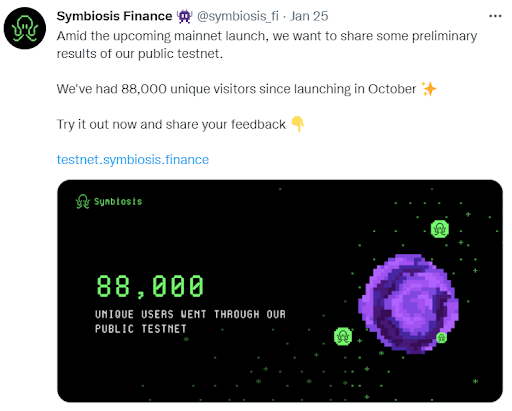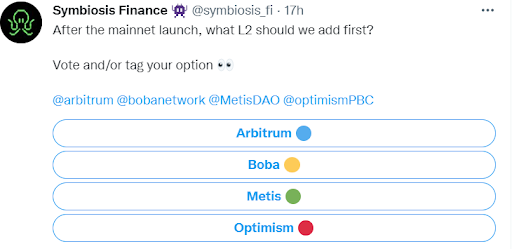Disclaimer: The text below is an advertorial article that was not written by Cryptonews.com journalists.
The blockchain space today is fragmented, with Ethereum maintaining its dominance and other players like Solana, Avalanche, among others, giving it tough competition. Slowly but steadily, blockchains other than Ethereum are increasing their market share, taking the industry down the road of multi-chain, which has many benefits, but their share of downsides, as well.
The first issue, which arises for crypto users, is the irregular distribution of liquidity across various blockchains. The next issue is that a user will have to use multiple applications just to get the most efficient trade routes for exchanging their tokens. Both of these problems are enough to throttle down the amazing growth that the crypto industry has observed so far. It’s not as if no protocols are trying to solve the problem. It’s just that they are failing at it because of their inherent deficiencies, which we will highlight here.
The current protocols aiming to solve this problem are way too complicated for users, as they require a user to go through a multi-step process, making it a time-intensive task. On top of that, their UX makes matters worse for the average crypto user. So, the question is, what’s the solution to this problem?
Well, that’s where Symbiosis Finance comes into the picture. With our innovative protocol, we have made it possible to move funds across different chains at low slippage. Highlighting “Low Slippage” is crucial here as high slippage is another cause of concern among crypto users.
So, if you are looking for the best crypto exchange rates, Symbiosis is the first protocol you should visit. After all, Symbiosis scans for the best available rates across thousands of cryptocurrencies. Let’s explore what Symbiosis does in more detail.
Facing “Liquidity Crunch” Head-on
As we said, Ethereum is still the go-to blockchain for building decentralized applications and tokens. But Ethereum’s scalability woes and high gas fees have led to the emergence of new-age, and comparatively faster blockchain platforms like Solana, Avalanche, Binance Smart Chain, among others. It has led to a narrative that these blockchain platforms are the so-called “Ethereum Killer.”
So, is this narrative correct? Absolutely not! In fact, what these platforms are doing is that they are laying the ground for what’s to come: Web 3.0. An interconnected blockverse is something truly needed for the mass adoption of blockchain technology and cryptocurrencies, by extension. Sounds great, right? But, block metaverse, as we like to call it, also leads to a problem of the irregular distribution of liquidity across different blockchains, causing higher price fluctuations and slippage.
We have taken it upon ourselves to solve this liquidity crunch by building bridges to connect various blockchains platforms enabling cross-chain communication in the process. And, the interest in our Symbiosis is obvious from the traffic we are receiving, as we have received 88,000 unique visitors since we launched in October.

It’s not like we are the only ones building such bridges, as the current number of bridges connecting blockchains already hovers around 30. The currently available solutions involve multiple steps just to move liquidity across chains, which makes it a cumbersome and lengthy process.
There are other players in the fray to make a mark in the multi-chain space like AnySwap and Synapse, but they, too, have so far not been able to make a considerable impact. Symbiosis is taking a different approach, which separates us from our competitors. We will explore what makes Symbiosis different from other protocols like AnySwap and Synapse a bit later in this article.
The Current Status
Symbiosis went live in October 2021 in a testnet mode, and so far, we have integrated with Ethereum (Rinkeby), Binance Smart Chain (Testnet), Polygon (Mumbai), Avalanche (Fuji), Huobi Eco Chain (Testnet), OEC, formerly known as OKExChain, with Solana integration on the horizon. Currently, Symbiosis is in the process of mainnet launch and also planning to aдdd more L2 networks in the coming days.

With over 90,000 users having used our public testnet so far, it’s time to take Symbiosis to mainnet, and with this, Symbiosis Network will become the first of its kind multi-chain platform allowing single-click swaps across different chains. The exact date will soon be made public.
As for our other plans for Q1 & Q2 2022, we already have exciting things lined up. It includes full-fledged Solana integration, which will initially be rolled out with a limited version, then Terra integration, which is already in development. We will also add more L1 & L2 networks in the coming days and also roll out Ethereum L2 SIS farming and SIS liquidity cross-chain farming. Besides that, we will also integrate with more browser extensions, wallets, etc.
Symbiosis Network vs. The Rest
Symbiosis believes in working with existing players in the market for the betterment of the industry. That is why we continue to build partnerships and integrate with various solutions regularly. It’s what separates us from our competitors, as our strategy is to work alongside the leading players in the industry rather than working against them.
Compared to AnySwap, which uses Fusion, Symbiosis Finance has instead chosen the path of blockchain agnosticism, as our blockchain network can be any of the cheap and efficient blockchain networks like Solana, Avalanche, etc. Also, we have not limited ourselves to only EVM-compatible blockchains, as visible on our roadmap.
Soon, we will integrate EVM-incompatible blockchains with smart contracts like Solana and Near as long as they support EdDSA/ECDSA key generation. As for blockchain networks that do not have smart contract functionality, like Bitcoin, we will be able to integrate them as well if they support ECDSA and HTLC contracts, as our Relayers have such capability. But, it won’t be possible to execute AMM logic directly with such blockchains without smart contract functionality.
Besides that, we are also using both concentrated liquidity pools and a 1inch-like routing that makes it possible to exchange any number of tokens through a single interface, which is our USP.
Symbiosis’s design makes it easy to embed in extensions, widgets, and mobile applications through SDK, among other things. Also, at Symbiosis, PoA is the relay network solution’s intermediate stage, where the final solution will take the shape of a truly decentralized and open network.
Our Backers
Symbiosis is backed by some of the biggest names in the crypto industry, which includes the likes of Blockchain.com, Amber Group, and Spartan Group.
Blockchain.com is one of the OGs that has been active in the industry since 2011 when it started out as a blockchain explorer. Later in 2012, they rolled out a crypto wallet that accounted for 28% of all Bitcoin transactions till 2020. Today, they are among the world’s leading crypto exchanges, with a daily trading volume of just over USD 57,772,282, which is equal to 1579 Bitcoins.
Founded by top financial professionals from Morgan Stanley, Goldman Sachs, and Bloomberg, Amber Group has traded over USD 1 trillion since its launch. It goes on to show how big they are in the trading world. With its presence in Asia, Europe, and the Americas, they serve the who’s who of the business world like HNWIs, family offices, and institutions.
Spartan Group is a blockchain advisory and consulting firm with roots in Singapore and Hong Kong. Having unveiled a USD 50 million DeFi venture fund in 2021, the firm founded in 2017 is currently doubling down on its efforts to invest in more game-changing DeFi projects. It has a unique vision of bridging the gap between the eastern and western markets and bringing them in sync with one another.
Overall, owing to our technology, concept, backers, and an incredibly talented team, Symbiosis Finance is uniquely placed to lead the blockchain world that is slowly but surely heading towards the multi-chain.
